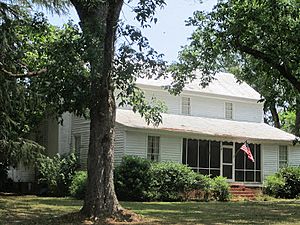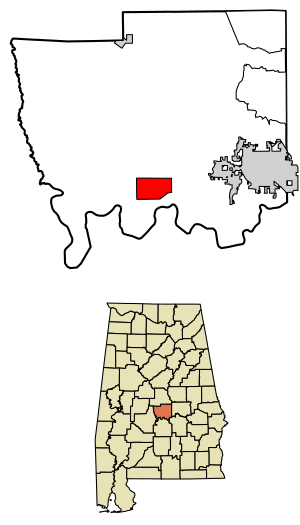Autaugaville, Alabama facts for kids
Quick facts for kids
Autaugaville, Alabama
|
|
|---|---|
|
Town
|
|
| Town of Autaugaville | |

The Lassiter House in Autaugaville, which is listed on the National Register of Historic Places.
|
|

Location of Autaugaville in Autauga County, Alabama.
|
|
| Country | United States |
| State | Alabama |
| County | Autauga |
| Founded | 1907 |
| Area | |
| • Total | 8.04 sq mi (20.82 km2) |
| • Land | 7.83 sq mi (20.29 km2) |
| • Water | 0.20 sq mi (0.53 km2) |
| Elevation | 161 ft (49 m) |
| Population
(2020)
|
|
| • Total | 795 |
| • Density | 101.49/sq mi (39.19/km2) |
| Time zone | UTC-6 (Central (CST)) |
| • Summer (DST) | UTC-5 (CDT) |
| ZIP code |
36003
|
| Area code(s) | 334 |
| FIPS code | 01-03220 |
| GNIS feature ID | 0113299 |
| Website | https://autaugavilleal.com/ |
Autaugaville is a small town located in Autauga County, Alabama, in the United States. In 2020, about 795 people lived there. It is considered part of the larger Montgomery area.
Contents
Exploring Autaugaville's Location
Autaugaville is in the central part of Alabama. You can find it at coordinates 32.432563 degrees North and 86.658752 degrees West.
How Big is Autaugaville?
The town covers a total area of about 7.8 square miles (20.2 square kilometers). Most of this area, about 7.6 square miles (19.7 square kilometers), is land. The rest, about 0.2 square miles (0.5 square kilometers), is water.
Roads and Travel
Alabama State Route 14 goes right through the middle of Autaugaville. This road connects the town to Prattville, which is 14 miles (23 km) to the east. Prattville is the main city in Autauga County. If you go west on the same road, you'll reach Selma, about 24 miles (39 km) away.
A Look Back at Autaugaville's History
The first settler in the Autaugaville area was William Thompson, who arrived around 1820. He built a gristmill (a mill for grinding grain) and a sawmill (a mill for cutting wood) on Swift Creek.
Early Growth and Industries
Some records say the town officially became a town in 1839, while others say 1907. In 1849, a cotton mill opened near Swift Creek. Like other industrial towns, the mill owner built homes for the workers, helping the town grow. Many people from a nearby town called Vernon moved to Autaugaville to avoid floods and diseases.
By 1851, Autaugaville had 351 residents. It also had four stores, two churches, and two schools. More businesses opened, including a cloth factory, a factory that made buggies and wagons, and another gristmill. This made Autaugaville an important place for manufacturing.
Challenges and Changes
In 1853, a big fire damaged the downtown area, but the town quickly rebuilt. Autaugaville's first and only newspaper, the Autauga Citizen, started in 1853 and ran until 1873.
The American Civil War (1861-1865) and the period after it, called Reconstruction, caused the town's factories to close. The cotton factory, for example, had its shipments taken by the U.S. government. This time period ended Autaugaville's role as a major manufacturing center.
The town officially incorporated in 1907. In 1911, the Alabama Central Railroad built a train line through the town. Some lumber mills continued to operate off and on until the 1930s. In 1936, a tree nursery for the Alabama Forestry Commission opened nearby.
Today, the Crystal Lake Manufacturing Company in Autaugaville makes brooms, mops, and handles, though it closed at the end of 2020. Many people in Autaugaville now work in the car parts industry.
Learning in Autaugaville
Autaugaville is part of the Autauga County School System. The town has one school, Autaugaville School, which teaches students from pre-kindergarten all the way to 12th grade.
Autaugaville's Population Over Time
The town of Autaugaville first appeared in the official U.S. Census in 1910.
| Race | Number of People | Percentage |
|---|---|---|
| White (not Hispanic) | 219 | 27.55% |
| Black or African American (not Hispanic) | 531 | 66.79% |
| Native American | 3 | 0.38% |
| Asian | 1 | 0.13% |
| Other/Mixed | 32 | 4.03% |
| Hispanic or Latino | 9 | 1.13% |
According to the 2020 United States census, there were 795 people living in Autaugaville. These people lived in 444 households, and 299 of those were families.
In 2010, the population density was about 114.2 people per square mile. The town's population was mostly Black or African American (66.8%) and White (31.3%). A small percentage were Native American, Asian, or from two or more races. About 0.8% of the population identified as Hispanic or Latino. The average household had 2.49 people, and the average family had 3.00 people.
Famous People from Autaugaville
- George "Wild Child" Butler – A talented blues guitarist, harmonica player, and singer.
- Albert J. Pickett – A planter, lawyer, and Alabama's first historian. He was born in North Carolina but moved to Autaugaville when he was 8 years old.
- Fernandez Ponds – A U.S. Navy admiral.
See also
 In Spanish: Autaugaville para niños
In Spanish: Autaugaville para niños

